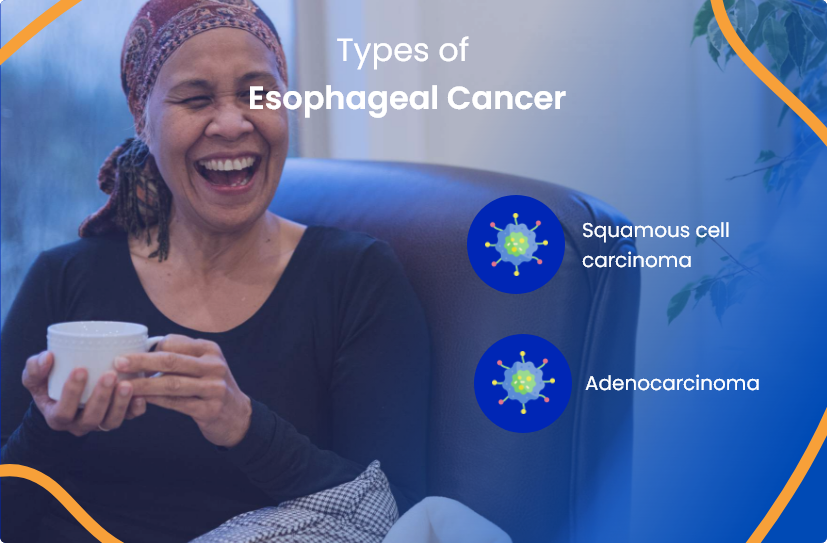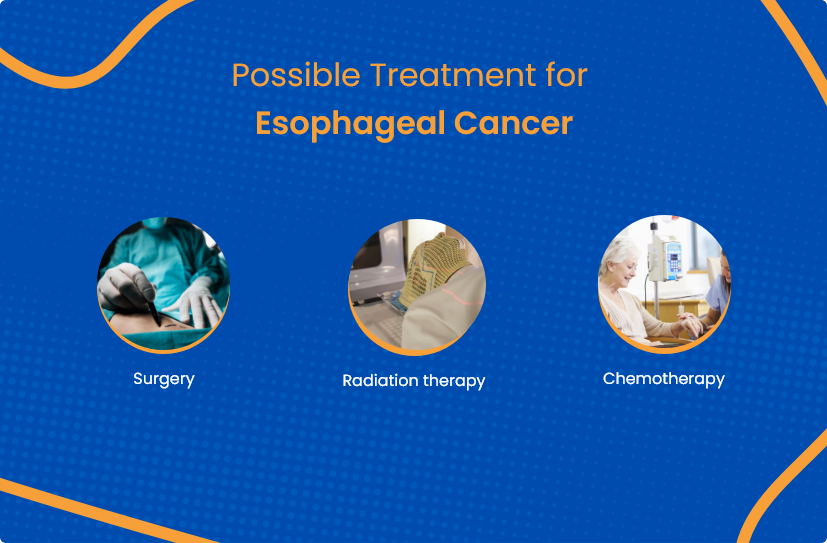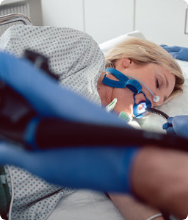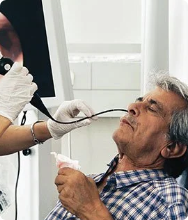
Book a Consultation
Thank you!
Your form has been sent successfully.

The esophagus is a hollow, muscular tube that carries food and liquid from the throat to the stomach. When abnormal cells form in the tissue of the esophagus, it is known as esophageal cancer. The disease originates in the inside lining of the esophagus. According to the American Cancer Society, esophageal cancer accounts for about 1% of all cancers diagnosed in the US. The lifetime risk of developing this disease is about 1 in 125 in men and about 1 in 417 in women.
Based on the type of cells in which esophageal carcinoma originates, there are two main esophageal cancer types:

Squamous cells line the inner layer of the esophagus. Squamous cell carcinoma begins in these cells and it can occur anywhere along the esophagus but is most commonly found in the upper and middle esophagus. It makes up less than 30% of esophageal cancers in the US.
Adenocarcinomas begin in gland cells and typically develop in the lower esophagus, near the stomach. Glandular cells in the esophageal lining produce fluids such as mucus.
Other rare types of esophageal cancer include: small cell carcinoma, sarcoma, lymphoma, melanoma, and choriocarcinoma.
Esophageal cancer symptoms or signs may include the following:
 Unexplained weight loss
Unexplained weight loss
 Having pain or difficulty swallowing
Having pain or difficulty swallowing
 Throat pain or pain behind the breastbone
Throat pain or pain behind the breastbone
 Burning in the chest
Burning in the chest
 Frequent choking on food
Frequent choking on food
 Coughing or hoarseness
Coughing or hoarseness
There are different esophageal cancer treatment options for patients:

Surgery is a common treatment for this disease and a part of the esophagus may be removed during the procedure. This operation is called esophagectomy. The esophageal cancer doctor will connect the remaining healthy part of the esophagus to the stomach so the patient can still swallow.
It uses high-energy x-rays or other types of radiation to kill cancer cells. External radiation therapy (using a machine outside the body to send radiation) and internal radiation therapy (using a radioactive substance sealed in catheters placed directly near cancer) are used to treat esophageal cancer.
This cancer treatment uses drugs to prevent the growth of cancerous cells either by killing the cells or stopping them from dividing.
To diagnose esophageal cancer, the doctor will conduct a physical examination to check for signs of disease, such as lumps. Apart from the physical exam, the following tests and procedures may be used:

A thin, flexible tube called an endoscope (with light & video camera) is passed down the throat and into the esophagus. It allows the doctor to see the lining of the esophagus.

In this procedure, the doctor inserts a thin tube with a light and a video camera on the end into the mouth or nose and down the windpipe. This test may be performed to determine whether a tumor is growing into the airway.

This procedure examines the esophagus for abnormalities. An esophagoscopy is inserted into the esophagus through the mouth or nose and down the throat.

It is the removal of a small amount of tissue from the suspected malignant area for examination. Other tests may indicate the presence of cancer, but a biopsy can provide a definitive diagnosis.
Our esophageal cancer specialists are dedicated to providing excellent patient care by prescribing effective, individualized treatment plans. On our team are some of Florida's most experienced providers. Our professionals strive to create a supportive environment for patients and their families throughout their cancer journey.
The following are our providers who you can consult at ACTC:

MD, Hematology & Oncology

MD, Ph.D., Hematology/ Medical Oncology

MD, Radiation Oncologist

ACTC has a clinical team with over two decades of experience supporting our caregivers and staff. We are committed to providing patients with personalized treatments at every stage. Our facility comes equipped with an infusion room, medical and radiation oncology exam rooms, a treatment vault, and cutting-edge diagnostic technology for esophageal cancer treatment.
Schedule a consultation by calling
 352-345-4565
352-345-4565
Stage 0 (high-grade dysplasia), stage I, stage II, stage III, and stage IV are the different stages of squamous cell carcinoma or adenocarcinoma of the esophagus.
Some esophageal cancer causes or risk factors include tobacco use, heavy alcohol use, gastroesophageal reflux disease (GERD), acid reflux, and Barrett's esophagus (where the cells lining the lower esophagus have changed or been replaced by abnormal cells).
The most common symptom of esophageal cancer is a sensation that food is stuck in the throat or that one is choking on food. These symptoms may worsen over time, causing pain when swallowing.
Schedule a consultation by calling
 352-345-4565
352-345-4565